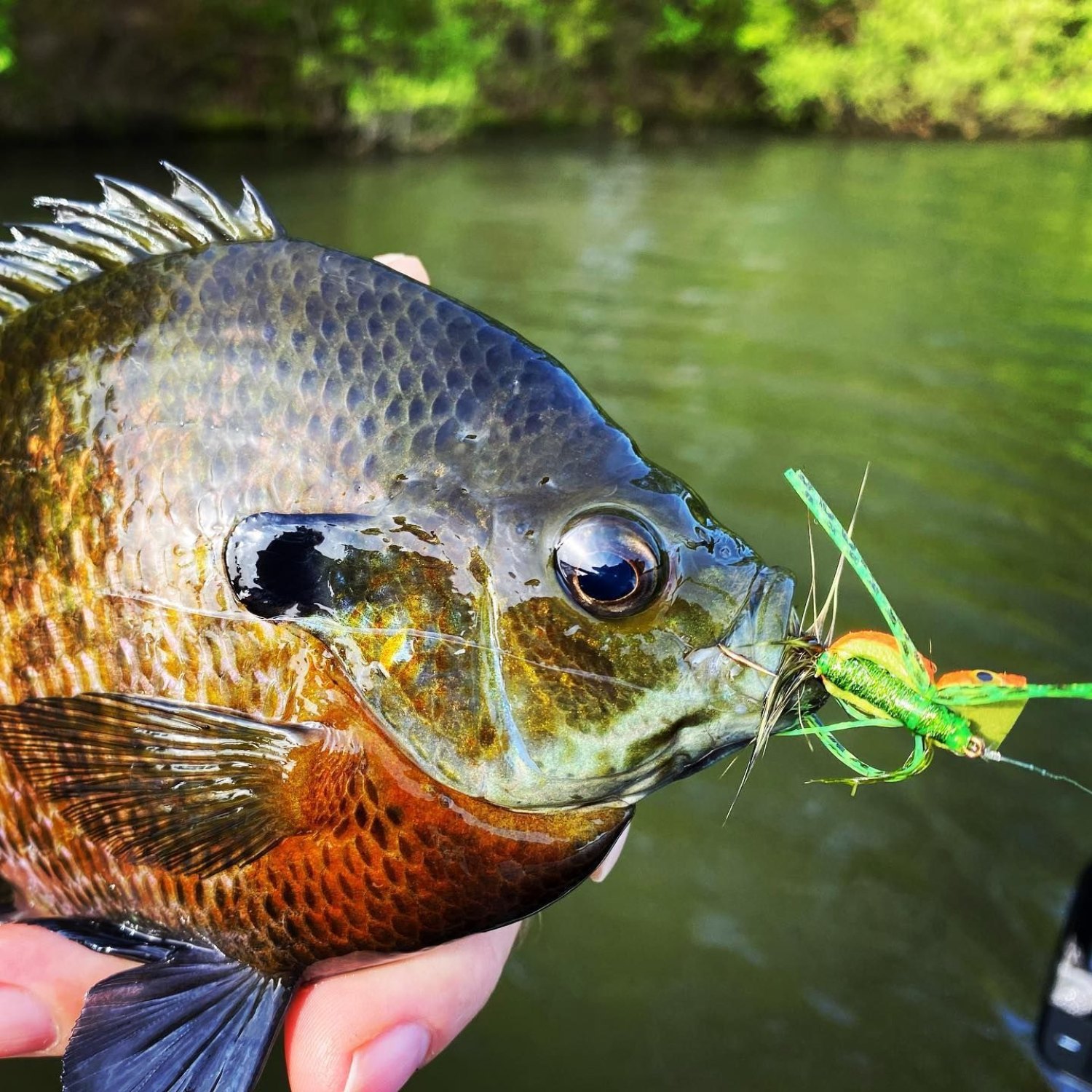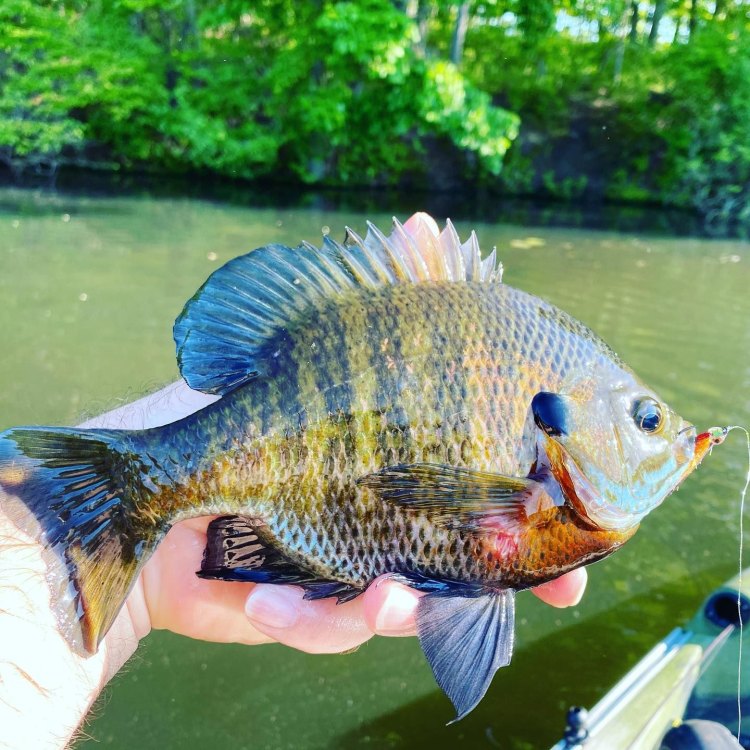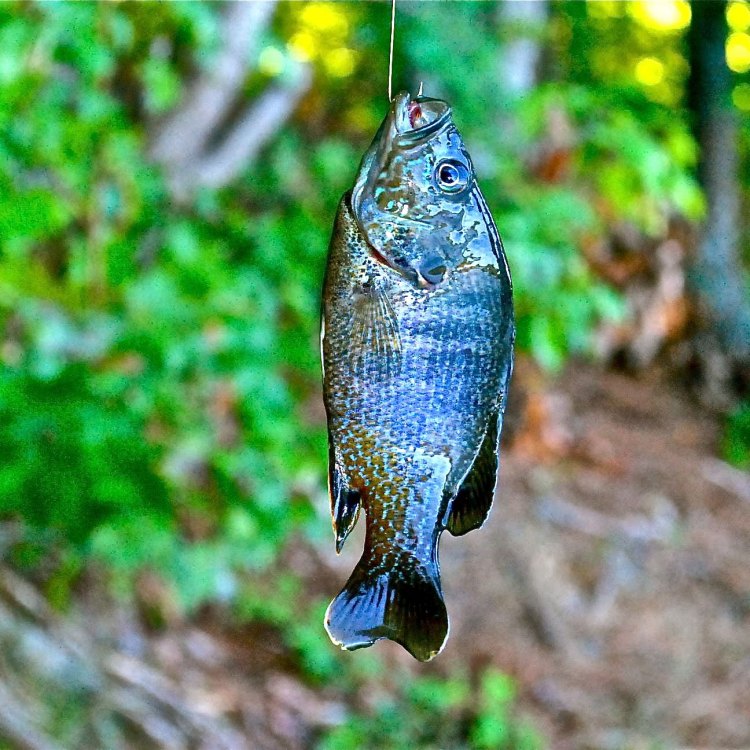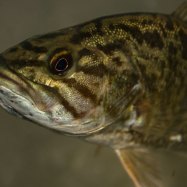
Bluegill
4-12 inches (10-30 cm)
The bluegill is a popular fish found in eastern and central North America. With a deep-bodied shape and average length of 4-12 inches, it belongs to the Centrarchidae family. Whether for sport or food, this colorful fish is a common sight in freshwater lakes and streams, making it a favorite among anglers. Keep an eye out for this feisty and resilient creature on your next outdoor adventure!
Animal Details Summary:
Common Name: Bluegill
Kingdom: Animalia
Habitat: Freshwater habitats such as lakes, ponds, and rivers
The Colorful World of Bluegills: Everything You Need to Know
Bluegills, also known by their scientific name Lepomis macrochirus, are one of the most common and colorful fish found in North America. These lively freshwater creatures are known for their vibrant coloration, deep-bodied shape, and wide distribution throughout the central and eastern parts of the continent. In this article, we will take a closer look at the remarkable features and behaviors of the Bluegill, from their habitat to their feeding habits.A Part of Animalia Kingdom
The Bluegill belongs to the Animalia Kingdom, which encompasses all animals Bluegill. This classification stems from their multicellular nature, heterotrophic feeding habits, and the presence of a nervous system. This means that Bluegills are not only gorgeous, but they are also complex creatures with a range of behaviors and characteristics.Chordata Phylum and Actinopterygii Class
Bluegills are also classified under the Chordata Phylum and Actinopterygii Class, along with other fish species. This classification is based on the presence of a spinal cord and bony internal skeletons. Bluegills have a sleek and streamlined body that allows them to move efficiently through the water, making them skilled predators and evasive prey.A Species of Perciformes Order and Centrarchidae Family
The Perciformes Order is the largest order of fish, with over 10,000 species. Bluegills are part of this order, which also includes popular fish such as perch, bass, and snapper. The Centrarchidae family is a group of freshwater fish found in North America, and the Bluegill is one of the most well-known species in this family.An Overview of Bluegill Habitat
Bluegills are commonly found in freshwater habitats such as lakes, ponds, and rivers, making them a popular target for anglers Banana Spider. They thrive in calm, shallow waters with plenty of vegetation, as this provides them with shelter and food sources. Bluegills are also known to inhabit muddy or sandy areas with little vegetation, as long as there is enough oxygen and food available.Distribution in North America
Bluegills are native to North America and can be found in the central and eastern regions of the continent, from Canada to Florida and as far west as Texas. They have also been introduced to other regions such as Europe, South America, and Asia, where they have become popular among anglers.The Origin of Bluegills in the United States
The Bluegill is a species that originated in the United States, specifically in the eastern part of the country. In the late 1800s, they were introduced to other regions through fish stocking programs and have since become widespread and highly sought after in the fishing world.The Beautiful Colors of Bluegills
Bluegills are easily recognizable by their stunning coloration. They have a dark olive-green color on their back and sides, with a yellowish belly and bright blue gill covers. These colors not only add to their aesthetic appeal but also serve as a natural camouflage, allowing them to blend into their surroundings and avoid predators.How Their Colors Change
One unique feature of Bluegills is their ability to change colors depending on their environment. They can be darker or lighter in different bodies of water, depending on the color of the substrate and the amount of sunlight. This makes them highly adaptable and able to thrive in a variety of habitats.The Unique Shape of Bluegills
Bluegills have a deep-bodied shape, which means they have a large, rounded body and are not very streamlined. This shape allows them to move easily in and out of vegetation, making them skilled ambush predators. They also have a large mouth that they use to devour their prey, which can range from small insects and larvae to larger fish.The Size of Bluegills
On average, Bluegills measure between 4-12 inches (10-30 cm) in length. However, larger specimens of up to 16 inches have been recorded. The size of Bluegills can vary greatly depending on their habitat and food availability. As mentioned earlier, they are opportunistic feeders, which means they will eat anything from insects and small fish to vegetation and algae.The Ideal Water Temperature for Bluegills
Bluegills thrive in warm water temperatures, with their preferred range being between 68-85 degrees Fahrenheit. This is why they are most active during the spring and summer months when water temperatures are at their peak. In colder temperatures, they will slow down and become less active, making them less likely to bite on fishing lures.Omnivorous Feeding Methods
As omnivores, Bluegills have a varied diet that consists of both plant and animal matter. They have a particular affinity for insects, worms, and small fish, which they hunt using their keen senses and agility. Bluegills also consume algae, plants, and seeds, making them an essential part of the food chain in their habitat.Angling Fun and Challenges
Bluegills are a sought-after catch for recreational anglers, as they provide a fun and challenging fishing experience. With their broad distribution and adaptive nature, Bluegills can be found in many bodies of water, making them accessible to anglers of all levels. They are also known for their fight, putting up a good struggle when caught on the line.Environmental Concerns
While Bluegills are a popular and abundant species, they are also facing threats in some areas due to human activities. Pollution, overfishing, and habitat destruction are among the most significant concerns for the Bluegill population. It is essential to practice responsible and sustainable fishing practices to ensure the future of this beautiful fish.The Indispensable Role of Bluegills in Freshwater Ecosystems
Bluegills play a crucial role in maintaining the balance of freshwater ecosystems. As mentioned earlier, they have a varied diet, which includes eating nuisance insects and controlling algae growth. They also serve as a food source for larger fish and birds, creating a ripple effect in the food chain. Without Bluegills, these ecosystems could potentially collapse, highlighting their importance in the natural world.In Conclusion
The Bluegill is a remarkable fish with a rich history and an essential role in freshwater ecosystems. Their vibrant colors, unique shape, and varied diet make them an interesting species to study, observe, and fish for. Whether you are an experienced angler or a nature enthusiast, the Bluegill is a fascinating creature that is sure to capture your attention. So next time you see a Bluegill in the water, take a moment to appreciate its beauty and significance in our natural world.

Bluegill
Animal Details Bluegill - Scientific Name: Lepomis macrochirus
- Category: Animals B
- Scientific Name: Lepomis macrochirus
- Common Name: Bluegill
- Kingdom: Animalia
- Phylum: Chordata
- Class: Actinopterygii
- Order: Perciformes
- Family: Centrarchidae
- Habitat: Freshwater habitats such as lakes, ponds, and rivers
- Feeding Method: Omnivorous
- Geographical Distribution: North America
- Country of Origin: United States
- Location: Eastern and central parts of North America
- Animal Coloration: Dark olive-green with a yellowish belly and sides
- Body Shape: Deep-bodied
- Length: 4-12 inches (10-30 cm)

Bluegill
- Adult Size: 6-10 inches (15-25 cm)
- Average Lifespan: 4-10 years
- Reproduction: Sexual
- Reproductive Behavior: Nests are built in shallow water by males to attract females
- Sound or Call: Produces low-frequency sounds during courtship
- Migration Pattern: Non-migratory
- Social Groups: Generally solitary or found in small groups
- Behavior: Active during the day
- Threats: Habitat loss, pollution, overfishing
- Conservation Status: Least Concern
- Impact on Ecosystem: Important prey for larger predators
- Human Use: Popular game fish for recreational fishing
- Distinctive Features: Ear-like black spot on the posterior edge of the gill cover
- Interesting Facts: Bluegills are often used as bait for larger predator fish
- Predator: Bass, walleye, pike, muskellunge

Lepomis macrochirus
The Colorful and Hardy Bluegill: A Fascinating Species of Sunfish
In the world of freshwater fish, the bluegill (Lepomis macrochirus) stands out for its vibrant colors, hardy nature, and unique features. Also known as blue sunfish, bream, or copper nose, this freshwater species belongs to the family Centrarchidae and is native to North America. As a popular game fish, the bluegill is prized for its delicious taste and is a frequent catch for recreational fishing enthusiasts. But there is much more to this fish than just its popularity as a game fish PeaceOfAnimals.Com. From its unique reproductive behavior to its impact on the ecosystem, the bluegill has many interesting features that make it a fascinating species to explore.Appearance and Adult Size
The bluegill is a small but striking fish that can reach an adult size of 6-10 inches (15-25 cm) in length. They have a round-shaped body with a olive-green to bluish back and a silver-white belly. The sides of their body are marked with dark vertical bars, giving them a striking appearance. The most distinctive feature of the bluegill is the dark spot on their gill cover, resembling an ear. This spot is more prominent in males and is used to attract females during breeding season.Lifespan and Reproductive Behavior
The average lifespan of a bluegill is 4-10 years, making it a relatively long-lived fish. They reach sexual maturity at around 2-3 years old. Reproduction in bluegills is sexual, with males building nests to attract females during the spawning season Bearded Vulture. These nests are built in shallow water, usually in areas with submerged vegetation or debris. The male bluegill will defend and maintain the nest while the female lays her eggs. After hatching, the male will protect the eggs and young until they are old enough to fend for themselves.Courtship and Sound Production
During courtship, the bluegills produce low-frequency sounds, which can be heard underwater. These sounds are used to attract and communicate with their potential mates. The males also use visual displays, such as flaring their fins and changing color, to signal their readiness for breeding. This intricate courtship behavior adds to the overall uniqueness of this species.Migration and Social Behavior
Unlike many other fish species, bluegills are non-migratory. They prefer to inhabit shallow water bodies, such as lakes, ponds, and slow-moving rivers, with a depth of less than 20 feet. Bluegills are generally solitary or found in small groups, although large schools can also be observed during the spawning season. They are active during the day and prefer to hide in the cover of vegetation or structure to avoid predators.Importance in the Ecosystem
As a vital part of the freshwater ecosystem, bluegills play a crucial role in maintaining the balance of their environment. They are an important prey for larger predators, such as bass, walleye, pike, and muskellunge, and their presence helps to control the population of these predatory species. Additionally, bluegills feed on aquatic insects, crustaceans, and small aquatic plants, helping to keep their populations in check. Any disturbance or decline in the bluegill population can have a cascading effect on the entire ecosystem.Threats to the Bluegill Population
Despite being listed as a species of Least Concern on the IUCN Red List, the bluegill population faces several threats. Habitat loss and degradation due to human development, pollution, and overfishing are some of the significant threats to this species. The construction of dams, canals, and other structures disrupts their natural habitats, affecting their reproduction and feeding. Pollution, primarily from agricultural and industrial runoff, can lead to water contamination, making it unsuitable for bluegills to survive. Overfishing, especially in popular fishing locations, can also lead to a decline in their population.Human Use and Conservation Efforts
The bluegill is a popular game fish, and its delicious, white flesh makes it a favorite catch for recreational fishing. However, there are regulations in place in many regions to manage the fishing of bluegills and ensure their sustainability. Additionally, many conservation efforts are in place to protect their habitats, which include restoring wetlands and controlling pollution. The health and abundance of the bluegill population are indicative of the overall health of its ecosystem, making its conservation an essential aspect of preserving the natural balance.Unique Features and Interesting Facts
Aside from its distinctive appearance, reproductive behavior, and important role in the ecosystem, bluegills have many other unique features. As mentioned earlier, the ear-like spot on their gill cover is a unique feature that sets them apart from other fish. Interestingly, this spot fades as the fish ages, making it a reliable indicator of a bluegill's maturity. Another interesting fact is that bluegills are often used as bait for larger predator fish because of their abundance in many freshwater systems.In Conclusion
In conclusion, the bluegill is a fascinating species of sunfish that has captured the attention of many fishing enthusiasts and researchers alike. This colorful and hardy fish has many unique features and behaviors that make it stand out from other freshwater fish. From its intriguing reproductive behavior and sound production to its distinctive appearance and role in the ecosystem, the bluegill has much to teach us about the wonders of the natural world. As we continue to learn more about this remarkable species, it's crucial to remember the importance of protecting its habitats and maintaining a sustainable population for generations to come.

The Colorful World of Bluegills: Everything You Need to Know
Disclaimer: The content provided is for informational purposes only. We cannot guarantee the accuracy of the information on this page 100%. All information provided here may change without prior notice.












